This article was posted by CrystalWind.ca.
Bats - Myths, Folklore and Facts
- Details
- Written by CrystalWind.ca
- Views: 43367

Bats
“Suspicions amongst thoughts are like bats amongst birds, they ever fly by twilight” Francis Bacon (1561-1626)
Of all the creatures associated with the night, perhaps the most misaligned and misunderstood is the Bat. Fictional characterizations in modern culture, in movies and on TV, have given the bat an evil and sinister reputation, but such could not be further from the truth. In Tonga and ancient Babylonia bats were considered physical manifestations of the Souls of the Dead. In China and Poland they were symbols of Happiness and Long life, and to the ancient Mayans they symbolized Transformation and Rebirth. So what better time than this Samhain to consider the characteristics and teachings of the Bat?
Myths and Folklore
Perhaps because of their nocturnal habits and ability to navigate in the dark, or simply because they appear to be both animal and bird at the same time, bats have long been associated with deity, supernatural forces and the occult. In the mythologies of differing cultures bats symbolize both good and evil, life and death. In China many legends associate bats with good fortune. To them, a group of five bats represented the five causes of happiness: wealth, health, long life, virtue and a natural death.
In South America among an ancient Mayan cult of the Quiche, located in the jungles of what is now Guatemala, Camazotz was a minor deity associated with bats. He was the God of the Caves and is described as having the body of a human with the head and wings of a bat. According to the Mayan sacred book of initiation rites Popul Vuh, he resided in the Bat-house located in the Underworld, a labyrinth of caves through which huge bats flew. While legends differ, he was responsible for the seventh test of initiation undertaken by the Mayan Hero Twins, the mythical Mayan ruling deities.
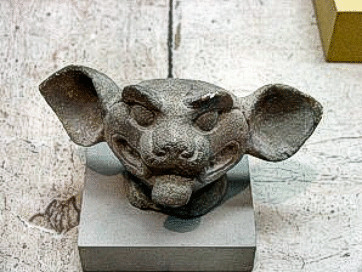 |
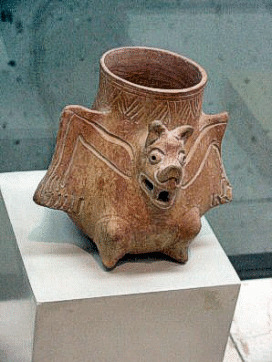 |
 |
In ancient Greece and Rome, it was thought that sleep could be prevented either by placing the engraved figure of a bat under the pillow, or by tying the head of a bat in a black bag and keeping it near to the left arm. On the Ivory Coast, even today, many think that bats are the spirits of the dead, and in Madagascar, they are assumed to be the souls of criminals, sorcerers and the unburied dead. In medieval Europe, bats were commonly thought to be witches’ familiars. In France 1332, Lady Jacaume of Bayonne was publicly burned simply because bats were seen to fly about her house and garden.
Also in Europe, in the Tyrol regions of Austria, it was believed that if a man wears the left eye of a bat on his person, he may become invisible, and in areas of central Germany, if he wears the heart of a bat bound to his arm with red thread, he will always be lucky at cards. It was commonly thought that witches used the blood of bats as an ingredient when making flying ointment, and further, to boost the powers of their magickal brews and potions. To the Gypsies, who were equally ostracized as witches, bats were seen as the bearers of good luck; they even prepared small bags containing dead bat bones for children to wear around their necks as charms.
In folklore, to wash your face in bat’s blood will enable you to see more clearly in the dark. To keep a piece of bat bone in your pocket will ensure good luck. Powdered bat’s heart will staunch bleeding or stop a bullet, and bullets from a gun swabbed with a bat’s heart will always hit their target. To put bat’s blood into someone’s drink will make him or her more passionate, and you can stimulate a woman’s desire by placing a drop of bat blood under her pillow. To prevent baldness or your hair greying, you should wash the hair in a concoction of powdered bat wings and coconut oil. The list of folklore concerning bats is endless, and even Shakespeare got in on the act. In his famous play Macbeth, he had his three witches adding “wool of bat” to their hellbroth, and in The Tempest (Act I, Scene 2) he had Caliban place a curse on his master Prospero, which included the line:
“All the charms of Sycorax, toads, beetles, bats, light on you!”
Bat as a Totem Animal
The bat as a totem animal is a symbol representative of transition and rebirth. A bat appearing in your life could mean that some aspect of your life is coming to an end, and rather than fear the change, you should embrace the transition and look forward to some kind of new beginning. It's a time for serious self-examination and self-evaluation. This may sound easy to do, but for most people change is a frightening experience. Bat’s appearance is there to help you soar above your fears by getting rid of those things in your life that are no longer needed. Only by facing the darkness of your uncertainties can you progress and find light in new beginnings.
To many misinformed people, the bat is a symbol of death, but try to embrace the positive powers of the bat. Bats typically live in deep underground caves, which symbolically is the belly of the Mother (Earth), and from these womb-like caves they emerge each evening at dusk - reborn. To a shaman the appearance of a bat does not signify actual or physical death, but more the death of old fears or the old ways of doing things that no longer serve you. By learning from the bat you can fly through any darkness into the light, be transformed, reborn and free.
“For as the eyes of bats are to the blaze of day, so is the reason in our soul to the things which are by nature most evident of all” - Aristotle (384-322 BC).
Bat Facts
Bats are mammals of the order Chiroptera of which there are 17 families divided into 2 suborders – the larger Megabats and the smaller Microbats. Only one of these families includes Megabats (of which there are more than 150 species); the other 16 families are all Microbats containing another 850 species or more. Bats are the only mammals capable of sustained flight, and are so prolific that the two orders together make up nearly one quarter of the world’s mammal population.
Bats are the most widely distributed group of mammals in the world. The ability of flight has enabled them to disperse and take up residence in most all countries, except for the Arctic, the Antarctic and a few isolated oceanic islands. Bats are more prolific in warmer countries however, such like Indonesia, home to about 175 species of bats, Venezuela to about 154 and Mexico to some 137. Central and South America is thought to be home to almost one third of the world’s total bat population. Sadly, as widely distributed as bats are, some species have drastically declined and many are now endangered.
The Megabat family includes some of the largest bats known; one such is the Giant Flying Fox of Africa, India and Malaysia (so called because of its fox-like face). The biggest Flying Foxes are found in Java and achieve a wingspan of 1.8 m (6 ft), a body length of 55 cm (22 in) and weigh up to 1.5 kg (3.3 lb). Flying Foxes are also known as Fruit Bats, because their main diet consists of fruit and flowers. Of the Microbat families, the smallest bat is the Kitti’s Hog-nosed bat (also called the Bumblebee bat), which is found only along the River Kwai in western Thailand. It measures only 3 cm (1 in) long and weighs about 2 g (0.07 oz), making it one of the smallest mammals living today.
 |
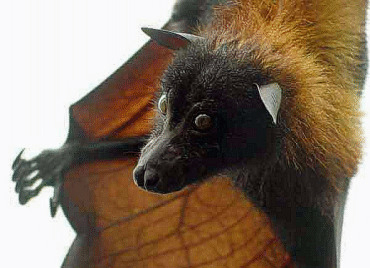 |
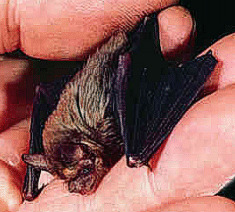 |
Aside from their size, Megabats and Microbats are different in many ways. Megabats have large eyes and mostly fox-like faces; while Microbats have small eyes and often elaborate facial structures. There is a myth that all bats are blind, but this is not true. Megabats see relatively well and rely on smell and vision to find their food, while Microbats have poorer eyesight and use a unique method of echolocation to orient and detect their food and prey. Echolocation is a high-frequency pulsing sound emitted by the bat that bounces back to its ears from surrounding surfaces thus giving away the location and relative distance of objects and prey within its environment. It’s a bit like the way sonar works in submarines. In this way bats are able to manoeuvre and navigate at night in almost total darkness.
Bats are the only mammals capable of true flight. Their wings consist of a thin, fleshy membrane supported near the leading edge by the greatly elongated bones of the forelimb and second finger, and towards the tip and rear by the third, fourth, and fifth fingers. It is further attached along the bodyline of the trunk and extends back between the hind limbs and tail. The thumb of the hand is free and has a sharp hooked claw to help in climbing. Their feet have five digits or toes, which are also equipped with sharp hooked claws, but these are used to help suspend the bat upside-down when roosting.
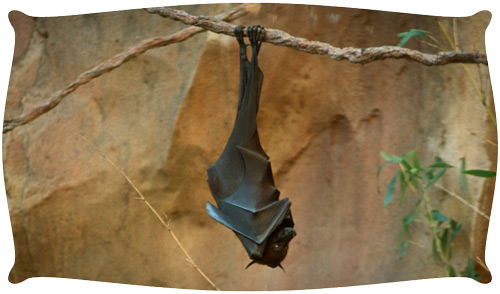
Most all bats are nocturnal. During the day they roost and rest in a variety of places, but commonly in dark caves and crevices, hollow trees or in shaded foliage, beneath rocks or bark and in abandoned buildings. Some Megabat species in warmer countries roost in more exposed areas where large colonies of bats can be seen hanging upside down from branches of trees. Being nocturnal gives bats many advantages, like reduced competition for insects and other food, freedom from attack by predators, and protection from overheating during the day which bats are especially susceptible to due to the size of their wings in relation to their body size. In countries where winters are cold bats will migrate to warmer climates or hibernate.
Female bats birth only one pup a year, which when born clings to the mother bat during flight and feeds from her milk. After approximately four months the pup learns to fly on its own. For many bat species mating takes place before hibernation, during which time the female stores the sperm in her genital tract throughout the winter and on awakening in spring uses it to fertilize her eggs.
For their diets, most Megabats feed on fruit, flowers, pollen and nectar, while Microbats also feed on insects, fish, frogs and other small creatures. A single Microbat can eat something like 3,000 insects in one night, and there is one species, the Vampire bat, that also feeds on the blood of other mammals. It is the Vampire bat, perhaps more than any other bat, that is responsible for fuelling the imagination of writers and film makers with fear and revulsion, and as a result, given the whole bat population such an evil and sinister reputation (more on this later).
Bats perform a vitally important ecological role in nature. Many rainforest trees depend on bats for pollination and seed dispersal, which is particularly important in facilitating regrowth after forest clearances. Similarly, many tropical plants depend on bats for the distribution of their seeds. It is estimated there are some 300 bat-dependent plant species yielding more than 450 economically valuable products. Some of these products include: Chewing gum, tequila, sisal, medicines, dyes and fuel. Even the bat’s waste matter, ‘guano’, is utilized as a valuable fertilizer. Some bats are the keystone species on which whole ecosystems depend for their survival.
Vampire Bats
Perhaps the most influential source for popularizing contemporary fears and dread about bats was the fictional bestselling book called “Dracula” (written by the Irish author Bram (Abraham) Stoker (1847-1912) and first published in 1897). In it, he personalized the characteristics of the Vampire bat into what are now the traditional scary blood sucking Vampire legends. Such did his book inspire the imaginations of other writers; it led to a whole plethora of similar stories and films on the subject.
In truth, there are only three species of Vampire bats that feed on the blood of other mammals (usually cattle, horses and large birds such as fowl). However, despite what popular legend would have us believe, bats do not suck blood. Bats have very sharp needle pointed teeth with which they make small incisions on the backs of large prey, and then lap at the resulting blood droplets. Most Vampire bats are quite small, commonly only 7 to 9 cm (2.75 to 3.5 in) long, and at best could manage to take only a tablespoon of blood each night from its prey, hardly enough to cause death by doing so.
One of the biggest fears people have concerning bats is Rabies. Rabies is a virus transmitted among animals, and sometimes humans, when bitten by an already infected carrier. However, a study conducted by the University of Florida has shown less than one-half of 1 percent of all bats have rabies. So in truth, the conclusion is that a human is more likely to be bitten by an unvaccinated rabid dog than by a Vampire bat. Far from being monsters, Vampire bats in general are sociable creatures, caring towards other members of their colony. They take part in mutual grooming, and will even take care of another’s abandoned young when unable to feed, this they do by regurgitating and sharing the blood they have collected for themselves.
Interestingly, new medical studies of a clot-dissolving substance found in Vampire bat saliva, could soon be used to benefit human Stroke victims.
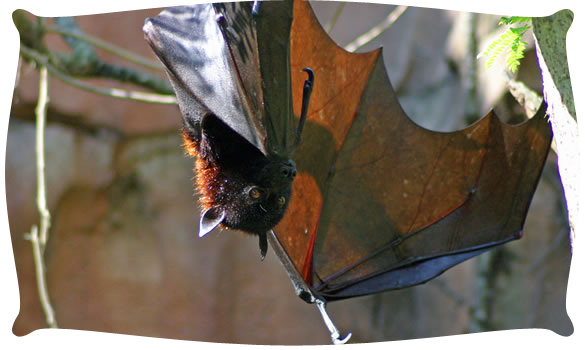
The original article is copyrighted by the author listed above. Posted on CrystalWind.ca © 2010-2024. All rights reserved. Reproduction of this content is prohibited without written permission. The title of the article was created by CrystalWind.ca.
© CrystalWind.ca 2024. All content (articles, imagery, fair use) & design protected. Written permission required for copying. All rights reserved.
Join the Conversation Now! Comment Below! ![]()

Spirit Animal Totem Of The Day!
Crystal Of The Day!
Latest Articles
CrystalWind.ca is free to use because of
donations from people like you.
Donate Now »

Unlock Your Light: Join Lightworkers Worldwide on CrystalWind.ca!
Articles: Lost Treasure
Articles: Shambhala
Follow Us!
Who is Online Now
We have 18947 guests and no members online
Featured This Month
Yule By The Hedgewitch
Yule Yule is a solar festival and one of the Minor Sabbats. This is when the ... Read more
Yule Blessings
Yule The Winter Solstice or Yule is one of the Lesser Wiccan Sabbats, and it ... Read more
Winter Solstice - A Season of Giving
CELEBRATING THE WINTER SOLSTICE The December solstice is also known as the ... Read more
Yule - The Winter Solstice
Yule, or the Winter Solstice is one of the lesser Sabbats of the Witches calen... Read more
Freeze Up Moon
Snake – Copper and Malachite – Thistle – Orange October 24 to November 21 ... Read more
Twas The Night Before Yuletide
Yule Chant Brightly burns the Yule log tonight Magic dances in firelight Ho... Read more
Gods and Monsters of the Winter Solstice
La Befana Because Santa Claus has presided over the Yule festival for the las... Read more



























































































































































